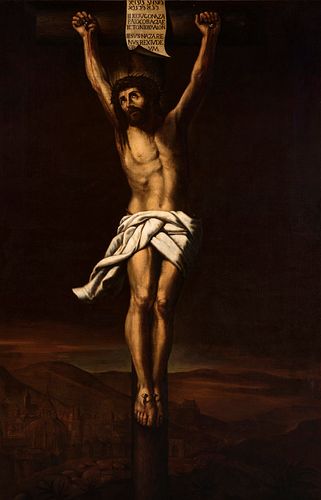Andalusian school; second half of the seventeenth century. "Christ crucified". Oil on canvas. Relined.
Lot 50
About Seller
Setdart Auction House
Carrer Aragó 346
Barcelona
Spain
Setdart Subastas was born in 2004 and is currently the first online art auction in Spain with solidity, prestige and reliability guaranteed by our more than 60,000 users. Setdart has a young, dynamic and enterprising team ready to successfully manage the purchase and sale of art works through custom...Read more
Estimate:
EUR€5,000 - EUR€7,000
$5,376.34 - $7,526.88
Absentee vs Live bid
Two ways to bid:
- Leave a max absentee bid and the platform will bid on your behalf up to your maximum bid during the live auction.
- Bid live during the auction and your bids will be submitted real-time to the auctioneer.
Bid Increments
| Price | Bid Increment |
|---|---|
| EUR€0 | EUR€10 |
| EUR€200 | EUR€25 |
| EUR€500 | EUR€50 |
| EUR€1,000 | EUR€100 |
| EUR€3,000 | EUR€200 |
| EUR€5,000 | EUR€500 |
| EUR€10,000 | EUR€1,000 |
| EUR€20,000 | EUR€2,000 |
| EUR€50,000 | EUR€5,000 |
About Auction
By Setdart Auction House
Nov 3, 2021
Set Reminder
2021-11-03 08:00:00
2021-11-03 08:00:00
America/New_York
Bidsquare
Bidsquare : OLD MASTERS
https://www.bidsquare.com/auctions/setdart-auction-house/old-masters-7786
Setdart Auction House sofia@setdart.com
Setdart Auction House sofia@setdart.com
- Lot Description
Andalusian school; second half of the seventeenth century. "Christ crucified". Oil on canvas. Relined. Presents repainting and restorations. It has Spanish frame of the seventeenth century. Measurements: 174 x 113 cm; 197 x 135 cm (frame). In an arid landscape of earthy tones, in the distance, the silhouette of a city of baroque architecture is outlined, which coexists with a wide landscape located in the right zone. This landscape conception, which reveals the mastery of the author, is somewhat relegated due to the great expressiveness of the main motif of the work. In the foreground, the artist places the figure of the crucified Christ, oversized with respect to the landscape in which he lives. The great monumentality of the figure, which occupies almost the entire surface, shows the viewer the relevance of the theme chosen by the author. He presents us with a Jesus, crucified with four nails, still alive, with his eyes open, directing his gaze towards the sky. His face adopts an expression where faintness and serenity meet, as a result of the acceptance of his destiny. However, despite the aforementioned serenity, the work is defined by dramatism, which derives from the technical treatment reflected in the anatomy of Jesus, or the way of painting the nails, especially the one on the left hand, where the tearing it has caused in the skin of Jesus can be appreciated. In addition, the light treatment of tenebrist heritage, shows us an image where the warm light is directed directly on the figure of Christ, while the rest of the scene is in semi-darkness. An element to emphasize is the cloth of purity, not only for the luminosity that it brings to the scene, or for the treatment of the cloths, but because the painter seems to make it float in the composition, moved by the air, a resource that in a certain way breaks with the strict verticality of the composition. The seventeenth century marked the arrival of the Baroque in the Andalusian school, with the triumph of naturalism over Mannerist idealism, loose workmanship and many other aesthetic liberties. At this time the school reached its greatest splendor, both for the quality of the works and for the primordial rank of Sevillian Baroque painting. Thus, during the transition to Baroque we find Juan del Castillo, Antonio Mohedano and Francisco Herrera el Viejo, in whose works the rapid brushstroke and the crude realism of the style is already manifested, and Juan de Roelas, introducer of Venetian colorism. In the middle of the century the period reached its peak, with figures such as Zurbarán, a young Alonso Cano and Velázquez. Finally, in the last third of the century we find Murillo and Valdés Leal, founders in 1660 of an Academy where many of the painters active during the first quarter of the 18th century were trained, such as Meneses Osorio, Sebastián Gómez, Lucas Valdés and others.
- Shipping Info
-
In-house shipping available. Please inquire at admin@setdart.com.
-
- Buyer's Premium



 EUR
EUR CAD
CAD AUD
AUD GBP
GBP MXN
MXN HKD
HKD CNY
CNY MYR
MYR SEK
SEK SGD
SGD CHF
CHF THB
THB

















